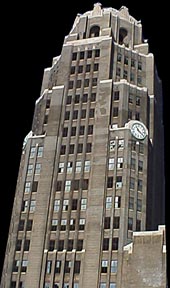
The Buffalo Central Terminal
by Ninjalicious and Liz
Buffalo, New York, is a lucky city. True, the weather is terrible, crime is high, the economy is dead and the suburbs are usually on fire, but Buffalo still has a lot going for it.
The city's main attraction is a tall, dark tower that bursts forth from otherwise flat land in the middle of a residential subdivision and soars 20 storeys up into the air. The looming, monolithic tower and the vast, art deco train station to which it is attached were constructed in 1929 and served the New York Central railway, the Penn-Central railway and later Amtrak until being abandoned in 1979. In its heyday, the giant Buffalo Central Terminal was a focal point of the industrial and social life of one of the largest cities in the United States, where the marble floors were kept glistening and immaculate and people dressed in their Sunday best. Today, the relic sits abandoned and empty, largely neglected by all but some local friends of the station and a few appreciative explorers. It remains quite possibly the most beautiful building in the world.
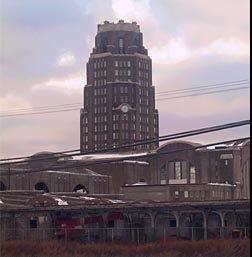 The Way In
The Way In
The BCT is a very big building with a hell of a lot of holes in it. While the powers that be occasionally make entering the building a slightly more challenging puzzle (blocking up doors, sealing useful indoor passageways and erecting a wire fence around much of the perimeter), they have never succeeded in building barricades that would thwart a determined explorer. Breaking in is not necessary — do a thorough perimeter check and you'll find a way in, though you'll probably have to start with a side building rather than the Great Hall.
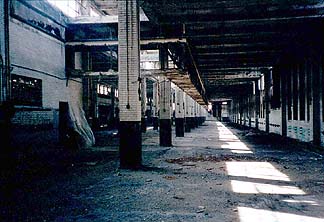
While the BCT's side buildings are outshined by the tower, the Great Hall and the basements next door, they are quite interesting in their own right.
While the side building isn't the main attraction, it is a very interesting place. The basement is usually flooded, and can only be explored during the coldest part of the year, when one can crawl around on top of six-foot-thick (you hope) ice. Several junk-filled stairwells lead up to the higher levels. The upper hallways are interesting, though many are filled with dust (particularly in areas where the roof has collapsed), water or ice, and in some you will be visible from outside the building. There are several interesting old rooms on the upper levels, including a telephone operators room, a fan room and an old, flooded library, still stocked with soggy or frozen books and typewriters. You can also get out onto a lower rooftop from here.
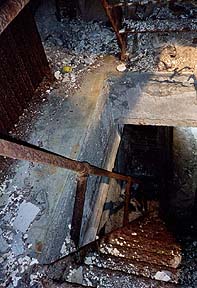 |
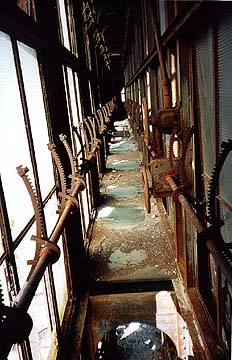 |
| One route from the side building into the Great Hall involves climbing through the remnants of a glass hallway. |
Though someone occasionally seals up some of the passageways between the side building and the Great Hall, most astute explorers will usually be able to find and navigate their way into the more interesting part of the station without causing any damage to the building. This may involve crossing the remnants of one of the several old glass hallways, the floors of which are now mostly destroyed. Wherever you come out, you should be able to easily make your way to the ground floor of the Great Hall.
The Great Hall
The BCT's Great Hall is an incredible sight; though decades of neglect and abuse have had an effect, scraping one's shoe through the caked-on muck on the ground reveals the marble floor underneath, and the tall, arcing ceiling of the Great Hall looks as fantastic as ever. In spite of being flooded and burned and spray painted and having every other window in the place smashed, the BCT is still the most magnificent and dignified building for miles around.
A look around the room reveals the details of another time: carefully etched street names cut into stone. Ticket kiosks done in gold leaf paint. Marble is everywhere — though not for lack of scavengers' trying — and is often sculpted into ornamental scrolls and the like. There is plenty to explore here, but the primary appeal of the Great Hall is its emptiness itself, in which you can see the sheer beauty of its past, and the magnitude of its abandonment. How could something that was ever this beautiful be discarded to time and decay like this?
The room is both stirring in its stillness and oppressive with the presence of ghosts. Dandily dressed travellers from New York City bustle by in the mind's eye, dutifully trailed by young porters — and of course, everyone has a jaunty hat. The Great Hall is a fine memorial to travel, in fact: it recalls both the excitement and the sadness of travel, becoming a real-life monument to that which we failed to appreciate in the rush of life, and that which we fail to preserve now in a society embarrassed to confront its ghosts.
To stand in the Great Hall is to truly feel part of a lost time, and there is little doubt that being there will take your breath away.
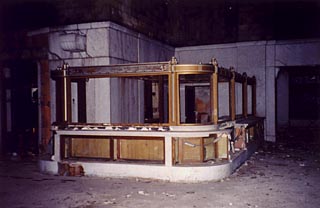
An abandoned ticket counter in the Great Hall.
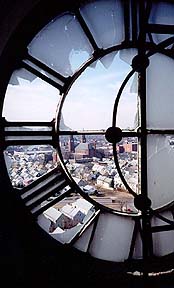 |
| The four clock faces on the building are now repaired and inaccessible. |
The Way Up
One must wade through the station's history in order to scale the tower, as large sections of the second and third floor are covered in old records and train schedules, and one of the stairways up is clogged with old paperwork up to two feet high. There are many places to explore on the way up. When I first toured the building in 1999, everything was open and accessible. Later, between 2000 and 2001, the tower's four clock faces were repaired, and solid new doors were installed to prevent any potential troublemakers from getting anywhere near the clocks on the 12th floor. More recently people have reported that loud alarms have been installed above the fourth floor and possibly in other locations.
No one has yet managed a good look at the alarms, and no one is yet completely clear on what causes them to go off. One point all reports have agreed upon is that they are extremely loud and usually inspire one to run from the building as quickly as possible. While setting off an alarm will never be a pleasant thing, potential explorers of the BCT can take some comfort in the knowledge that one could easily hide in the gigantic station for weeks without being found by the police, who aren't likely to ever try to bring dogs into the building. While it isn't likely that anyone who sets off the alarm will actually have to face any consequences, setting off the alarm is obviously a very nasty thing to do with potentially nasty consequences for future explorers, so please don't do it.
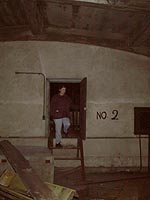 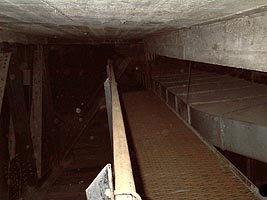 There is lots to see on the way up, including catwalks over top of the Great Hall.
There is lots to see on the way up, including catwalks over top of the Great Hall.
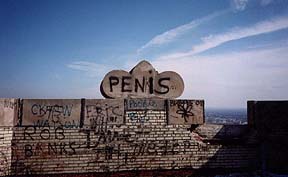 |
| The view from the roof is spectacular. |
Those who do get further up will be rewarded; the floors near the top are full of interesting spots. Towards the top, the building narrows and begins to slope inward, and small holes in the walls admit enough outside sunlight to illuminate the dust that fills the air, so that it feels as if one is climbing up the inside of a pyramid. A narrow iron staircase leads up from the upper mechanical rooms out to the small, octagonal rooftop, where the walls are all thoroughly coated in graffiti. The view from the roof of the station is spectacular.
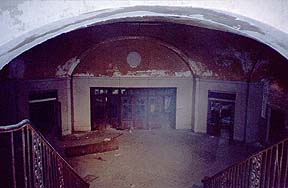 |
| An old reception hall in the basement. |
The Basement and Beyond
From the Great Hall, the most direct route into the station's very interesting basements is through the employee corridors at the back of the kitchen. These extremely narrow hallways and staircases lead down to corridors featuring a bizarre three-level maze of larger rooms, hallways, semi-flooded steam tunnels, ladders and ornate staircases, some of which were bricked up at some stage in the building's lifetime. While one will find occasional mechanical rooms, shops, a corridor containing a car stripped bare, vacated apartments used by houseless people and the occasional very attractive landing, the vast majority of the spaces down here are completely empty rooms. There are a few hours' worth of stuff to see in the station's basements alone, and it would be easy to get lost if one didn't pay attention.
From the basement, it's a pretty simple matter to navigate one's way across a little fenced-in courtyard (once a driveway underneath the hallway connecting the tower and the Great Hall to the train loading platforms) to another side building, where there are plenty of further architectural and archaelogical oddities to be found, including strange empty rooms, large unused pits, old scales and other souvenirs of the station's industrial past.
Please note: if you damage, deface or remove anything from the BCT, I will hunt you down and kill you. This is nothing personal. Thank you for your understanding in this matter.
|

